Top 10 Scandi Home Decor Ideas to Transform Your Home. Scandinavian (Scandi) home decor, known for its minimalism, functionality, and warmth, has become a favorite across the globe. Its clean lines, neutral palettes, and cozy textures create inviting spaces that feel both modern and timeless. Here are ten must-have Scandi home décor pieces that will elevate your home with effortless style.
Neutral Color Palette
Scandinavian interiors typically revolve around neutral color palettes, focusing on whites, beiges, grays, and soft pastels. This simplicity creates a calm and cohesive look.
The neutral color palette is a defining characteristic of Scandinavian interiors, serving both aesthetic and practical purposes. Here’s a more detailed explanation:
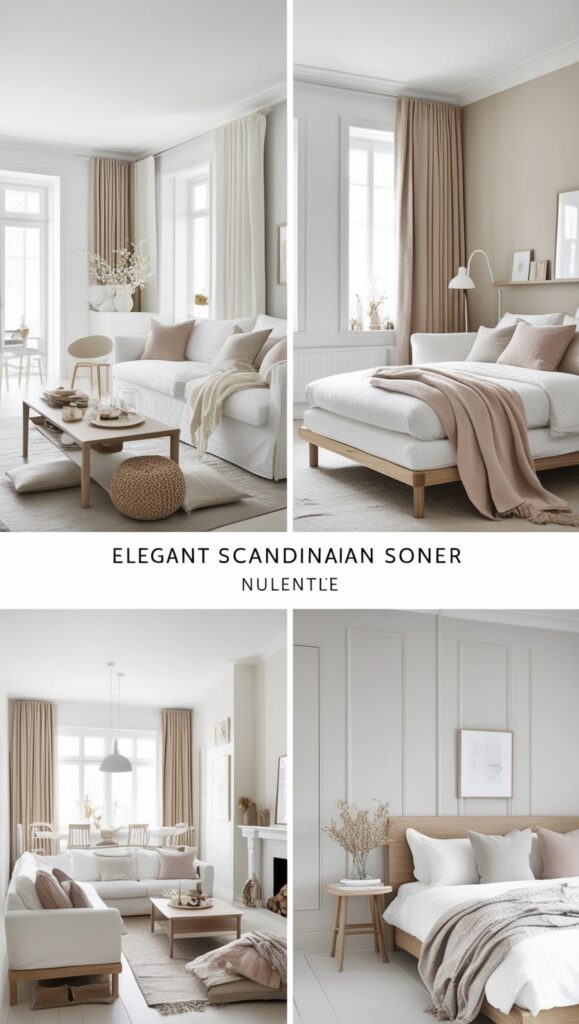
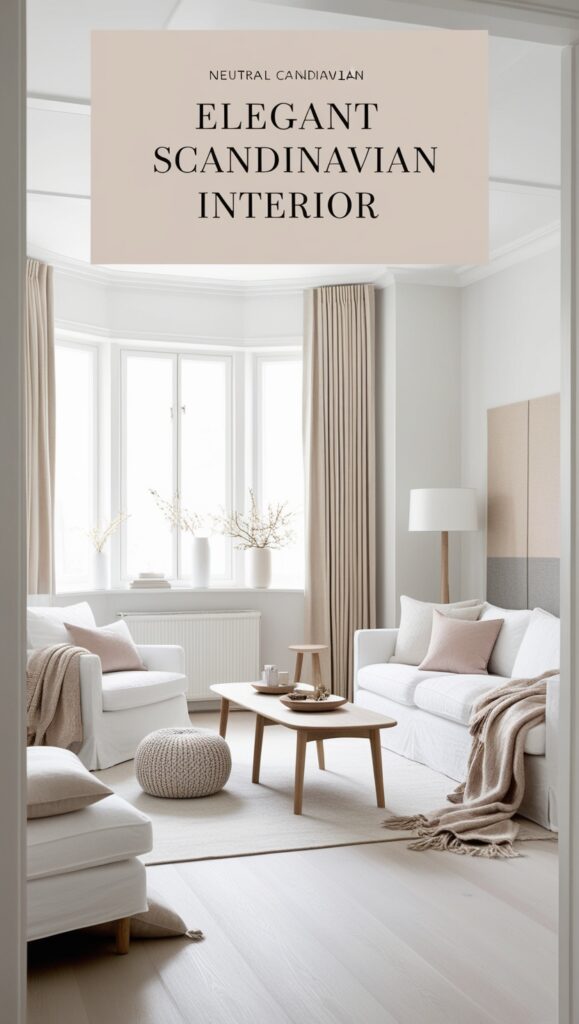
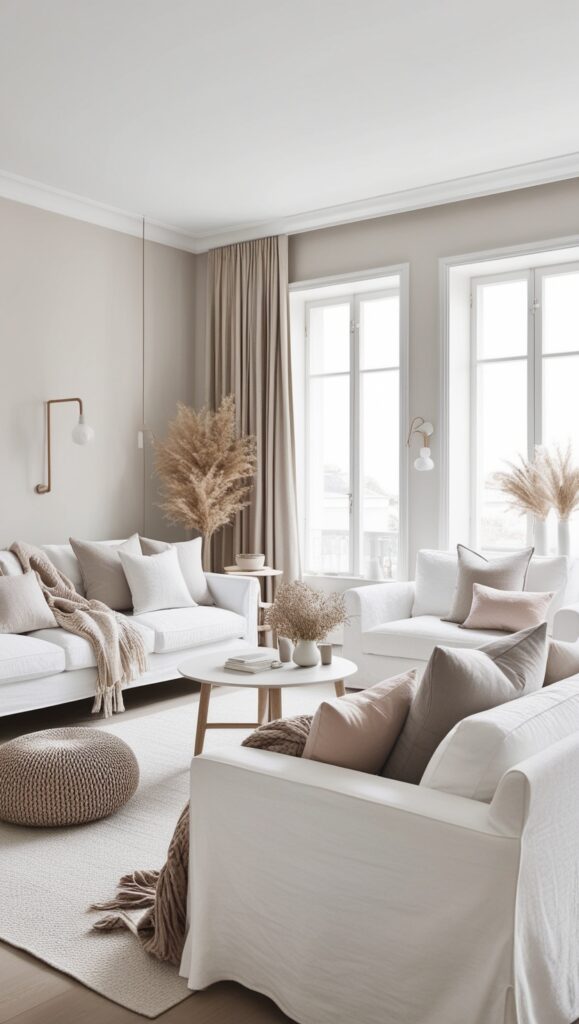
- Color Selection:
- Whites and Off-Whites: These shades create a bright and airy atmosphere, making spaces feel larger and more open. White walls are often used to maximize natural light, which is crucial in the Nordic regions where daylight can be limited.
- Beiges and Taupes: These warm neutrals add a touch of coziness and comfort. They can be used in furniture, textiles, and decor, providing a soft contrast against brighter whites.
- Grays: This versatile color ranges from light to dark shades, offering a modern touch while still feeling inviting. Gray can serve as a backdrop for other elements in the room, balancing bolder accents.
- Soft Pastels: Subtle hues like pale blue, mint green, or blush add a hint of color without overwhelming the senses. These shades can introduce a gentle warmth or a refreshing vibe while maintaining the overall calm aesthetic.
- Creating Calm and Cohesion:
- Simplicity: The use of a neutral palette fosters a minimalist approach, eliminating visual clutter and creating a serene environment. This simplicity aligns with the Scandinavian design philosophy of “hygge,” which emphasizes comfort and well-being.
- Layering Textures: Neutral colors allow for the layering of different textures—such as soft wool throws, woven rugs, and smooth ceramics—adding depth and interest without disrupting the cohesive look.
- Natural Elements: Neutral tones harmonize well with natural materials like wood and stone, reinforcing the connection to nature that is central to Scandinavian design.
- Versatility:
- Timelessness: Neutral palettes are timeless and versatile, allowing homeowners to update decor with colorful accents or seasonal changes without the need for a complete redesign.
- Personalization: While the base colors remain neutral, the style can be personalized through artwork, decorative cushions, and plants, making the space feel unique while still adhering to a cohesive look.
- Impact on Space:
- Light Reflection: Neutral colors reflect light, enhancing the brightness of a room, which is particularly beneficial in areas with limited natural light.
- Open Feel: A neutral color scheme contributes to an open and airy feel, making even smaller spaces seem more expansive and inviting.

- Wooden Furniture
Scandi design often incorporates natural wooden elements, which bring warmth and balance to the neutral tones of the décor. Light woods like pine or birch are commonly used.
Wooden furniture is a cornerstone of Scandinavian design, playing a vital role in creating inviting and functional spaces. Here’s a more detailed exploration of the significance and characteristics of wooden furniture in Scandi interiors:
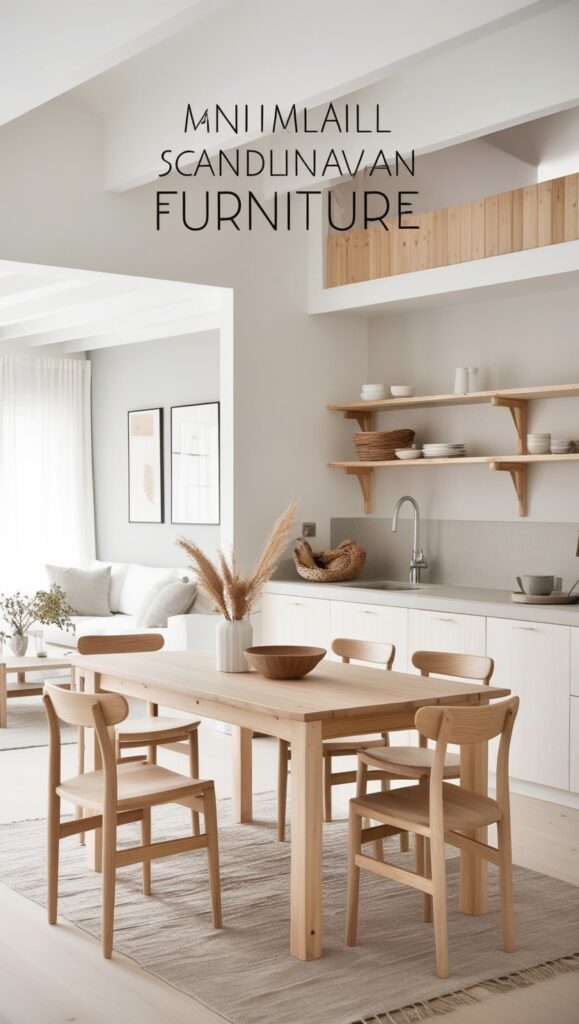
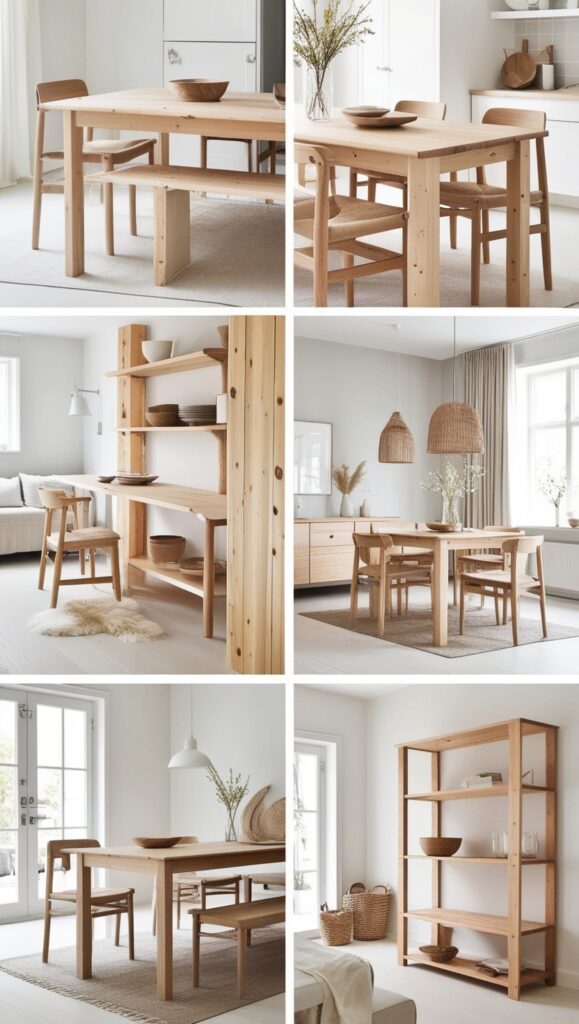
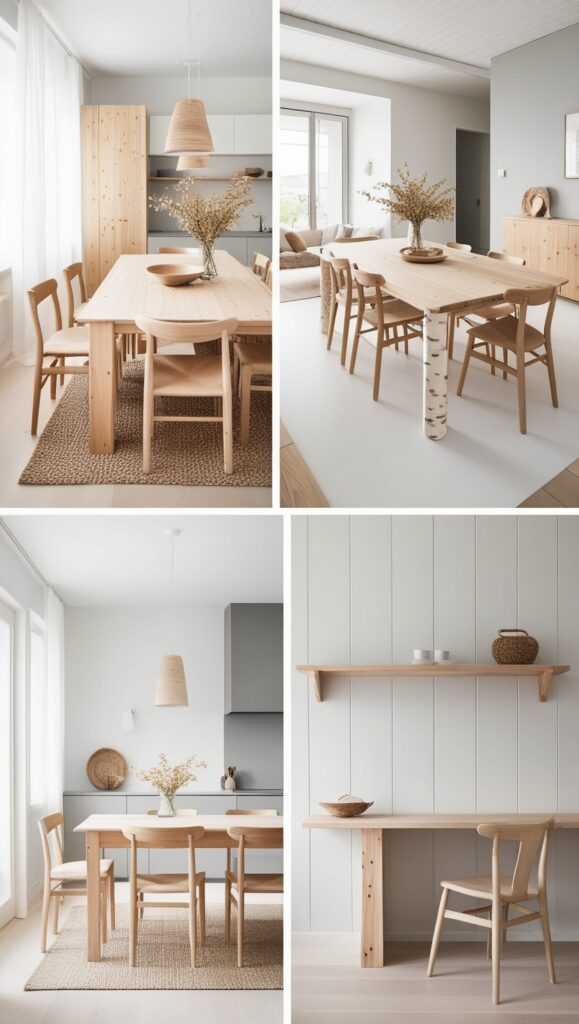
- Natural Aesthetics:
- Organic Appeal: Wooden furniture introduces organic shapes and textures that contrast beautifully with the smooth, clean lines of modern design. This natural aesthetic enhances the overall warmth of a space, making it feel more welcoming.
- Color Variations: The natural hues of wood, ranging from light to medium tones, complement the neutral color palettes commonly used in Scandinavian homes. Light woods like pine and birch create a soft backdrop that adds depth without overwhelming the space.
- Materials:
- Pine and Birch: These woods are frequently chosen for their light color and durability. Pine has a subtle grain and is often used for furniture like tables and chairs, while birch, with its smooth finish, is ideal for cabinetry and accents.
- Sustainable Choices: Scandinavian design often emphasizes sustainability. Using responsibly sourced wood reflects an eco-friendly approach, aligning with the region’s strong connection to nature.
- Functionality and Simplicity:
- Practical Design: Scandinavian furniture is designed to be functional without compromising style. Many wooden pieces serve multiple purposes, such as storage solutions that also act as decorative elements.
- Minimalist Approach: The simplicity of wooden furniture aligns with the minimalist ethos of Scandinavian design. Clean lines and uncluttered forms promote a sense of calm and order, reducing visual noise in the home.
- Warmth and Comfort:
- Tactile Qualities: Wooden surfaces feel warm and inviting to the touch, enhancing the comfort of a room. This tactile quality is especially appealing in areas like living rooms and bedrooms, where relaxation is key.
- Contrast with Textiles: Wooden furniture works harmoniously with textiles such as wool, linen, and cotton, which are often used in Scandinavian decor. The combination of hard and soft materials creates a balanced and cozy environment.
- Timelessness:
- Enduring Style: Wooden furniture has a classic appeal that transcends trends. Its timeless nature means that pieces can be integrated into a variety of design styles, making them a valuable investment.
- Aging Gracefully: Wood develops a unique patina over time, adding character and depth to furniture. This aging process is often celebrated in Scandinavian design, as it tells a story and enhances the piece’s charm.
- Cohesion with Nature:
- Biophilic Design: Incorporating wooden elements fosters a connection to nature, which is central to Scandinavian philosophy. This biophilic approach contributes to well-being by creating a soothing and harmonious living environment.
- Indoor-Outdoor Flow: Wooden furniture complements large windows and open spaces often found in Scandi homes, blurring the lines between indoor and outdoor living and maximizing the use of natural light.

- Sheepskin Rugs
Adding a touch of softness and comfort, sheepskin rugs are a popular element in Scandi homes. They’re often draped over chairs or placed on the floor for extra coziness.
Sheepskin rugs are a quintessential element of Scandinavian design, valued for their aesthetic appeal and functional benefits. Here’s a deeper exploration of their significance and characteristics in Scandi interiors:



- Aesthetic Appeal:
- Natural Texture: Sheepskin rugs introduce a luxurious, soft texture that contrasts beautifully with the clean lines and minimalist designs typical of Scandinavian interiors. Their plush surfaces add warmth and depth to spaces, enhancing the overall aesthetic.
- Versatile Colors: Available in various natural shades—from creamy whites and soft grays to rich browns—sheepskin rugs complement a range of color palettes, especially the neutral tones prevalent in Scandi design.
- Comfort and Warmth:
- Cozy Atmosphere: Sheepskin rugs are synonymous with comfort. Their soft fibers provide a warm surface underfoot, making them perfect for areas where people relax, such as living rooms or bedrooms. They help create a cozy ambiance that encourages relaxation.
- Insulation: Beyond their visual appeal, sheepskin rugs offer practical benefits by providing insulation against cold floors. This is particularly beneficial in Scandinavian homes, where winters can be harsh and chilly.
- Functional Use:
- Versatility: Sheepskin rugs can be used in various ways, such as draped over chairs, layered over other rugs, or placed on the floor. This versatility allows homeowners to experiment with placement and styling, enhancing the overall decor of a room.
- Easy to Clean: Most sheepskin rugs are relatively easy to maintain. Regular shaking and occasional spot cleaning can keep them looking fresh, making them a practical choice for busy households.
- Connection to Nature:
- Natural Materials: Using sheepskin aligns with the Scandinavian philosophy of incorporating natural materials into interior design. This connection to nature promotes a sense of calm and well-being, reflecting the ethos of “hygge,” which emphasizes comfort and coziness.
- Biophilic Design: Sheepskin rugs contribute to biophilic design principles, bringing elements of the outdoors inside. This approach fosters a tranquil atmosphere that connects inhabitants with their environment.
- Layering and Texture:
- Layering Techniques: Sheepskin rugs are often used to layer textures in a room. When placed over a hardwood or carpeted floor, they create visual interest and enhance the tactile experience of the space.
- Complementing Other Textiles: They pair well with other textiles, such as cotton throws and linen cushions, allowing for a cohesive yet varied design. This layering of different materials enriches the overall aesthetic and comfort of a room.
- Timelessness and Style:
- Classic Design: Sheepskin rugs have a timeless quality that transcends trends. Their ability to adapt to various styles—from rustic to modern—makes them a staple in many homes, ensuring they remain relevant in ever-changing decor landscapes.
- Personal Expression: With various shapes and sizes available, sheepskin rugs offer opportunities for personal expression in home decor. Whether used as a statement piece or a subtle accent, they can reflect individual style preferences.

- Open Shelving
Open shelving is a hallmark of Scandinavian design, providing both functional storage and a place to display minimalistic decor, such as ceramics or plants.
Open shelving is a defining characteristic of Scandinavian design, combining functionality with aesthetic appeal. Here’s a deeper look at its significance and features in Scandi interiors:

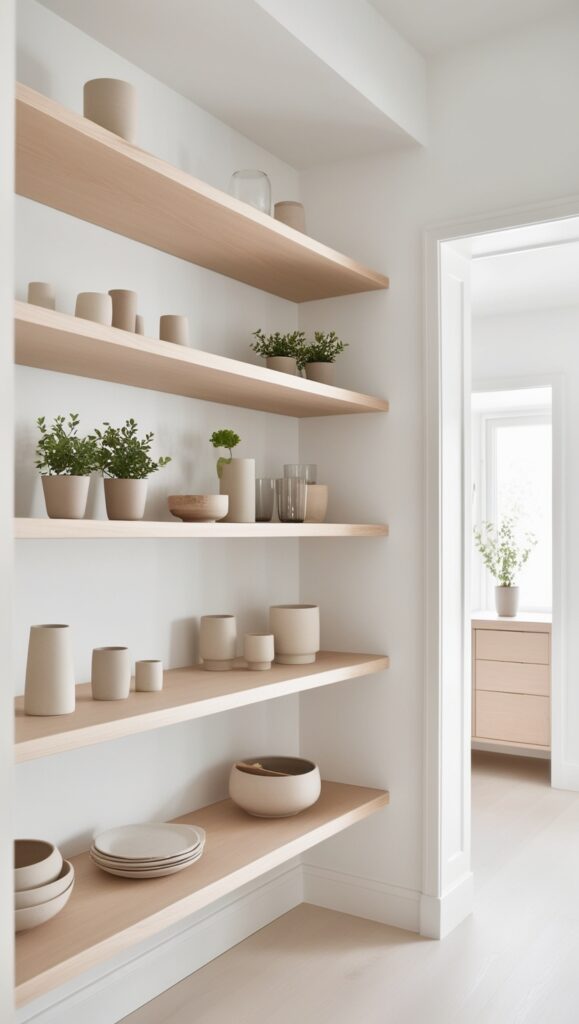
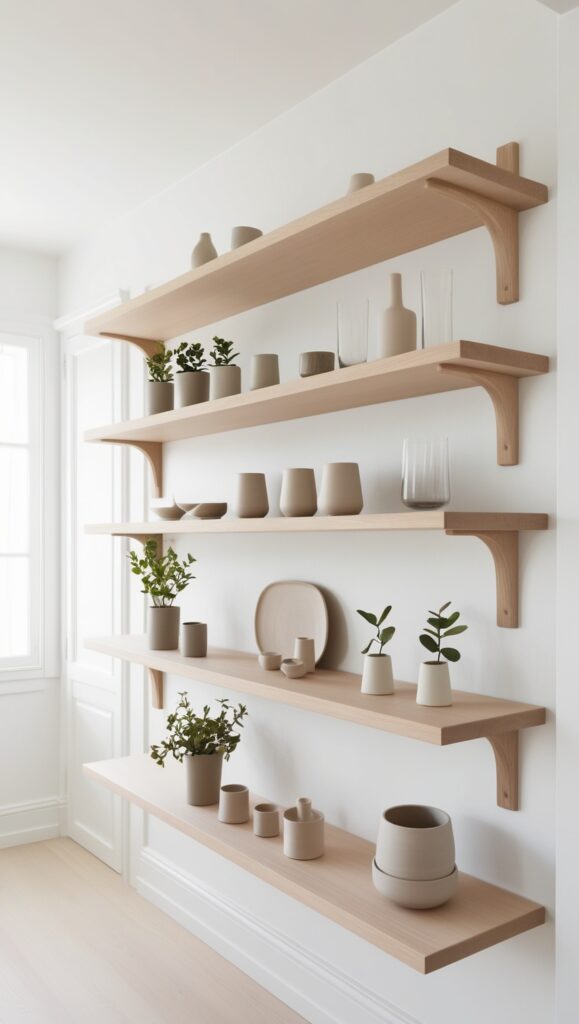
- Functional Storage:
- Maximizing Space: Open shelving allows for efficient use of vertical space, making it ideal for small homes or kitchens. By removing the need for bulky cabinets, open shelves create an illusion of a larger, more open area.
- Easy Accessibility: Items stored on open shelves are easily accessible, making it convenient to grab dishes, utensils, or decorative items. This practical aspect aligns with the Scandinavian emphasis on functionality in home design.
- Minimalistic Aesthetic:
- Simplicity in Design: Open shelving promotes a minimalist approach, showcasing only essential items. This simplicity helps maintain a clean and uncluttered look, which is a fundamental aspect of Scandinavian interiors.
- Highlighting Decor: The lack of cabinet doors allows for the display of beautiful ceramics, glassware, and curated decor items. This encourages homeowners to choose visually appealing objects that reflect their style, enhancing the overall aesthetic of the space.
- Showcasing Natural Materials:
- Wooden Shelving: Often made from natural wood, open shelves contribute to the organic feel of Scandinavian design. The warmth of wood complements the cool tones typical of Scandinavian decor, adding texture and depth to the space.
- Integration with Other Elements: Open shelving can seamlessly integrate with other design elements, such as wall colors, flooring, and furniture, enhancing the overall harmony of the room.
- Encouraging Organization:
- Thoughtful Arrangement: Open shelving encourages homeowners to be intentional about their storage. Since everything is visible, it motivates a more organized approach to displaying items, leading to a more cohesive look.
- Decluttering: By using open shelves, individuals are less likely to hoard unnecessary items, as the visibility of the stored objects prompts regular evaluation and decluttering.
- Versatility:
- In Various Spaces: Open shelving can be used in different areas of the home, including kitchens, living rooms, and bathrooms. This versatility makes it a popular choice for showcasing personal style in any room.
- Customization: Homeowners can customize open shelving according to their needs and preferences. Adjustable shelves and modular designs allow for flexibility in how items are displayed and stored.
- Bringing Nature Indoors:
- Display of Plants: Open shelving provides a perfect opportunity to showcase indoor plants, enhancing the connection to nature that is central to Scandinavian design. The addition of greenery brings life and freshness into the home, creating a calming atmosphere.
- Natural Light Enhancement: By utilizing open shelves, natural light can flow more freely throughout the room, creating a brighter and more inviting environment.
- Timeless Style:
- Long-Lasting Appeal: The use of open shelving is not only trendy but also timeless. Its classic appeal means it can adapt to changing design trends without losing its charm.
- Personal Expression: Open shelving offers an excellent opportunity for personal expression. Homeowners can curate their collections, reflecting their personality and style while contributing to the overall decor.

- Minimalist Lighting
In Scandi homes, lighting is functional but also stylish, with simple pendant lights or floor lamps in neutral colors. The lighting complements the clean and minimalist look of the space.
Minimalist lighting is a fundamental aspect of Scandinavian design, playing a crucial role in creating the desired ambiance while maintaining functionality. Here’s a deeper exploration of its significance and characteristics in Scandi interiors:



- Functional and Stylish:
- Purpose-Driven Design: In Scandinavian homes, lighting is not just about aesthetics; it serves a practical purpose. Fixtures are designed to illuminate spaces effectively while adding to the overall decor. This functional approach ensures that every lighting element serves a specific need, whether for reading, cooking, or relaxing.
- Sleek Silhouettes: Scandinavian lighting designs often feature clean lines and minimalist forms. Simple pendant lights and streamlined floor lamps enhance the aesthetic without overwhelming the space, reflecting the core principles of Scandinavian design.
- Neutral Color Palette:
- Soft and Inviting: Most lighting fixtures in Scandi homes come in neutral colors, such as whites, grays, and soft beiges. These tones blend seamlessly with the rest of the decor, creating a cohesive and calming atmosphere. Neutral lighting fixtures ensure that they enhance rather than distract from the overall design scheme.
- Versatility: The use of neutral colors allows lighting fixtures to complement a wide range of interior styles and color palettes. This versatility makes it easy to switch up decor without needing to replace the lighting.
- Natural Light Emphasis:
- Maximizing Daylight: Scandinavian design prioritizes the use of natural light. Large windows and minimal window treatments allow ample daylight to flood the space, reducing the need for artificial lighting during the day. When lighting is needed, fixtures are chosen to enhance this natural illumination.
- Mood Enhancement: By strategically placing lighting fixtures, homeowners can create different moods throughout the day. Soft, diffused lighting in the evening can foster a cozy atmosphere, while brighter lights can be used for task-oriented spaces.
- Layered Lighting:
- Combining Sources: Minimalist lighting in Scandinavian homes often involves layering different types of lighting—ambient, task, and accent. This combination creates a well-lit environment that caters to various activities and moods. For example, pendant lights over a dining table provide ambient light, while floor lamps in reading nooks offer focused illumination.
- Creating Depth: Layering different light sources helps to create depth and dimension in a space. This approach adds visual interest while maintaining a minimalist aesthetic.
- Sustainability and Efficiency:
- Energy-Efficient Solutions: Many Scandinavian homes prioritize energy efficiency, and lighting is no exception. LED fixtures and energy-efficient bulbs are commonly used to reduce energy consumption while providing ample light. This eco-friendly approach aligns with the broader Scandinavian ethos of sustainability.
- Long-Lasting Designs: Minimalist lighting fixtures are often designed to be timeless, ensuring they remain stylish and functional for years to come. This longevity contributes to sustainability by reducing the need for frequent replacements.
- Personal Expression:
- Showcasing Style: While minimalist lighting is often simple, it also allows for personal expression. Unique pendant designs or sculptural floor lamps can serve as focal points in a room, showcasing the homeowner’s taste while adhering to a minimalist philosophy.
- Cohesive Look: Thoughtfully chosen lighting fixtures can tie together various elements of a room, creating a harmonious and cohesive look that reflects the overall Scandinavian design principles.
- Enhancing the Space:
- Visual Expansion: Well-placed lighting can make spaces feel larger and more open. By illuminating corners and highlighting architectural features, lighting enhances the perception of space, a vital consideration in many Scandinavian homes, which often emphasize open floor plans.
- Creating Focal Points: Strategic lighting can highlight artwork, furniture, or unique design elements, drawing attention to the features that define a home’s character.

- Indoor Plants
Nature is an essential part of Scandinavian design, and indoor plants bring freshness and life into minimalist spaces. Popular choices include small potted plants, ferns, and succulents.
Indoor plants are a vital element of Scandinavian design, infusing spaces with life, color, and a connection to nature. Here’s a deeper exploration of their significance and characteristics in Scandi interiors:
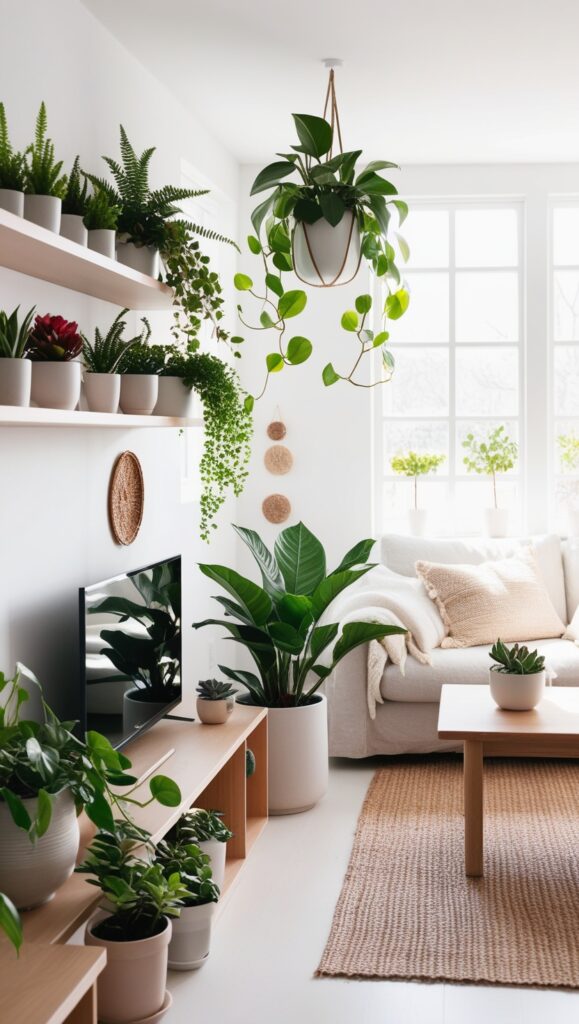
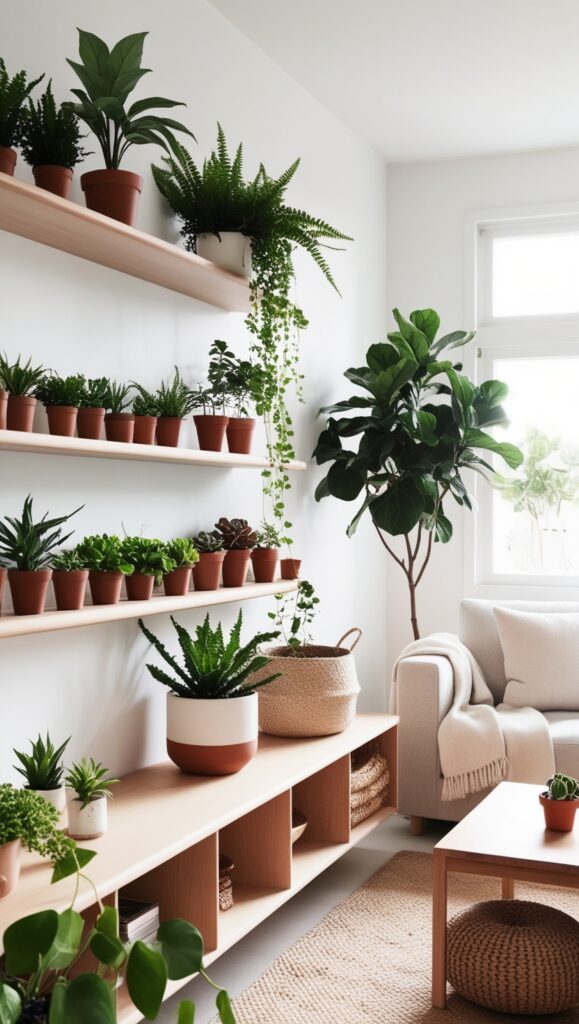
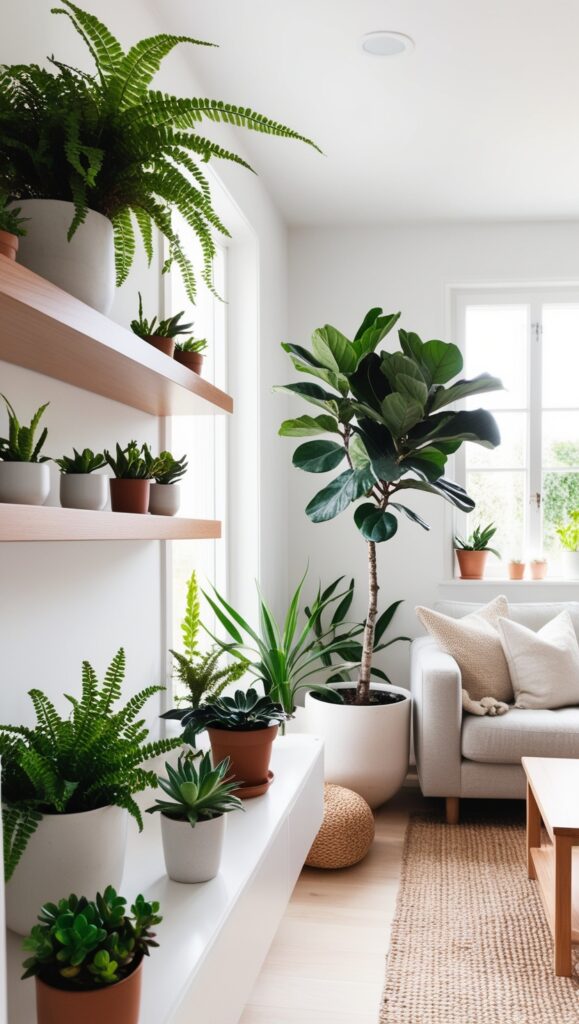
- Connection to Nature:
- Biophilic Design: Incorporating indoor plants into home decor aligns with biophilic design principles, which emphasize a strong connection to the natural environment. This connection is particularly important in Scandinavian design, where nature is often celebrated and integrated into everyday living.
- Promoting Well-Being: Bringing greenery indoors contributes to a sense of calm and tranquility. Studies have shown that indoor plants can reduce stress, improve air quality, and enhance overall well-being, making them a desirable addition to any home.
- Freshness and Vitality:
- Liveliness in Minimalism: In minimalist spaces, where simplicity and neutral color palettes prevail, indoor plants serve as a refreshing contrast. They add vibrancy and warmth to the decor, creating a more inviting and cozy atmosphere.
- Seasonal Changes: Indoor plants can also provide a dynamic aspect to interior design, as they grow and change with the seasons. This brings a sense of life and continuity to the home, fostering a deeper connection to the natural world.
- Popular Plant Choices:
- Small Potted Plants: Compact plants, such as pothos or peace lilies, are popular in Scandinavian homes due to their ease of care and ability to thrive in low-light conditions. They can be placed on shelves, windowsills, or desks, contributing to a clean, uncluttered look.
- Ferns: Ferns, with their lush foliage, add a touch of greenery while complementing the minimalist aesthetic. They can be hung in macramé planters or displayed in stylish pots, enhancing the visual interest of a room.
- Succulents: Known for their unique shapes and low maintenance, succulents are ideal for those who appreciate a modern, minimalist vibe. They come in various colors and sizes, making them versatile options for any space.
- Strategic Placement:
- Highlighting Spaces: Indoor plants can be strategically placed to highlight specific areas or architectural features. For example, a tall plant in a corner can draw the eye upward, making the space feel larger and more open.
- Layering Textures: Plants introduce natural textures into a room, which is particularly beneficial in minimalist designs that prioritize clean lines. By incorporating various plant shapes and sizes, homeowners can create a layered and visually appealing environment.
- Seasonal Decor:
- Festive Touches: Indoor plants can also play a role in seasonal decorating. For instance, seasonal plants like poinsettias or small evergreen arrangements can add a festive touch during the holidays, enhancing the home’s overall decor.
- Year-Round Beauty: While certain plants may thrive in specific seasons, many indoor plants offer year-round beauty. This allows homeowners to maintain a green presence in their homes regardless of the weather outside.
- Sustainability:
- Eco-Friendly Choices: Opting for indoor plants reflects a commitment to sustainability. Many plants are low-maintenance and require minimal resources, making them an environmentally friendly choice for home decor.
- Air Quality Benefits: Indoor plants help purify the air by absorbing toxins and releasing oxygen, contributing to a healthier living environment. This aligns with the Scandinavian ethos of creating spaces that promote well-being and sustainability.
- Personal Expression:
- Curating Collections: Indoor plants offer opportunities for personal expression. Homeowners can curate collections of their favorite plants, reflecting their personality and style while contributing to the overall decor.
- Mixing with Decor: Plants can be paired with various decor elements, such as ceramic pots, wooden stands, or modern planters, allowing for creative combinations that enhance the visual appeal of a room.

- Textured Throw Blankets
Scandinavian interiors prioritize coziness, and nothing adds warmth like textured throw blankets. Soft wool or knitted blankets are perfect for draping over sofas or chairs.
Textured throw blankets are an essential element in Scandinavian interiors, contributing to the overall sense of warmth and coziness that characterizes this design style. Here’s a deeper exploration of their significance and features in Scandi decor:
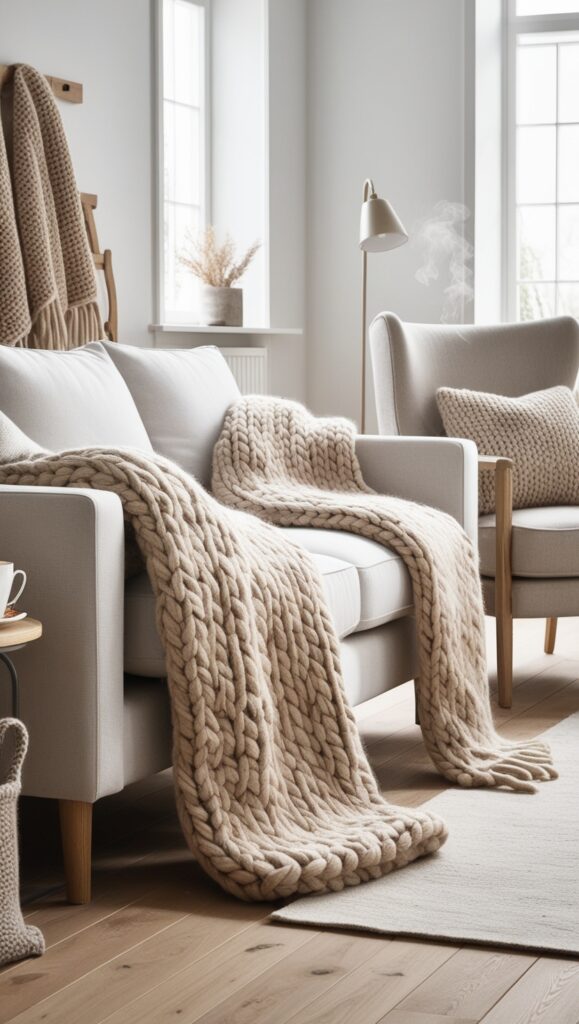
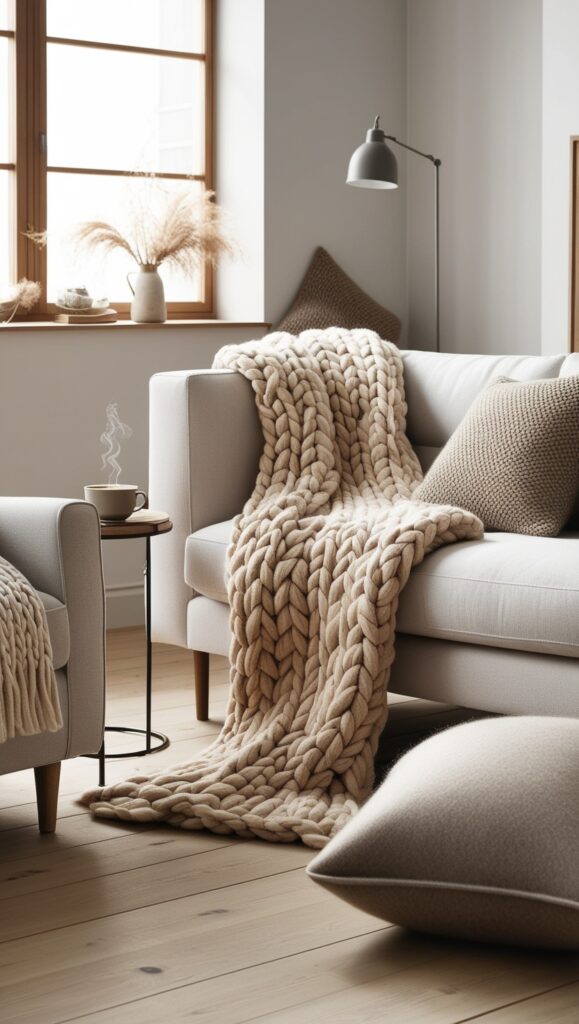
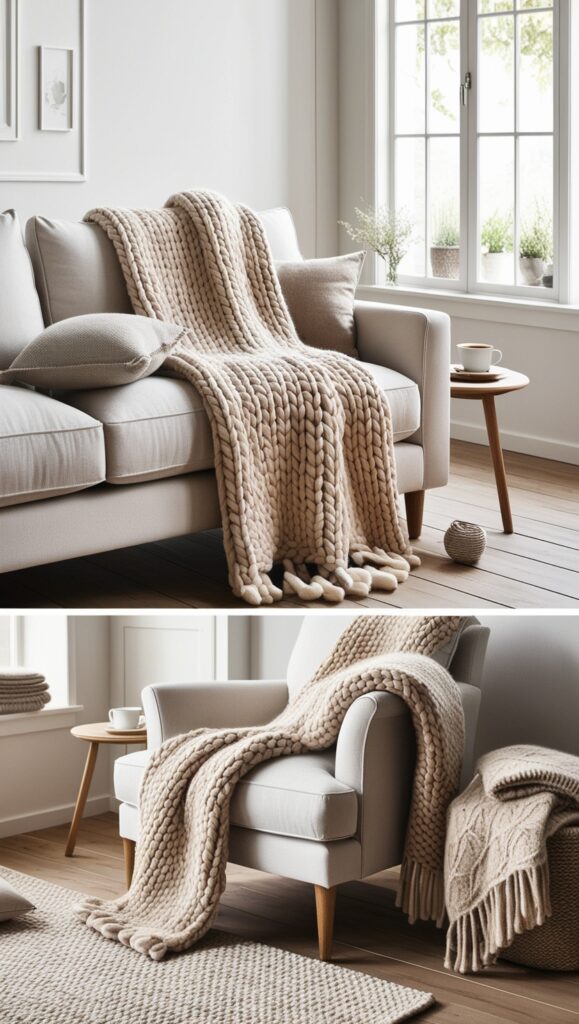
- Emphasis on Coziness:
- Creating a Welcoming Atmosphere: In Scandinavian design, the concept of “hygge” (a Danish term that denotes a feeling of coziness and comfort) is paramount. Textured throw blankets are key in achieving this ambiance, making spaces feel inviting and comfortable.
- Warmth in Minimalism: While Scandinavian interiors often feature minimalist aesthetics with clean lines and neutral colors, textured blankets introduce warmth and softness. They provide a tactile element that contrasts with hard surfaces and adds a sense of homeyness.
- Variety of Textures:
- Soft Wool and Knitted Fabrics: Popular choices for throw blankets include soft wool, cashmere, or knitted fabrics. These materials not only add warmth but also create visual interest through varied textures. The tactile quality of the blankets invites touch, enhancing the overall sensory experience of the space.
- Mixing Textures: Combining different textures, such as a chunky knit throw with smooth linen cushions, allows homeowners to create layers that add depth and dimension to their decor. This layering technique aligns with the Scandinavian aesthetic of simplicity and functionality.
- Functional Decor:
- Practical Use: Beyond their decorative appeal, textured throw blankets serve a practical purpose by providing warmth and comfort on chilly evenings. They can be easily draped over sofas or chairs, making them readily accessible for use.
- Versatile Styling: Throw blankets can be styled in various ways, whether casually tossed over the arm of a chair or neatly folded on a shelf. This versatility allows for creativity in how they are incorporated into the overall design.
- Seasonal Adaptability:
- Year-Round Comfort: Textured blankets are not limited to winter use; they can be used year-round to add comfort. Lightweight throws are perfect for summer evenings, while heavier, warmer blankets can provide extra coziness during colder months.
- Seasonal Decor: Homeowners can switch out blankets to reflect the changing seasons. Lighter colors and fabrics may be favored in spring and summer, while richer, darker hues can enhance the cozy feel of fall and winter.
- Color and Pattern Choices:
- Neutral and Earthy Tones: Scandinavian interiors often emphasize a neutral color palette, and textured throw blankets typically follow suit. Soft whites, grays, beiges, and muted pastels fit seamlessly into the overall aesthetic.
- Subtle Patterns: While many throw blankets feature solid colors, others incorporate subtle patterns or textures, such as herringbone or geometric designs. These details add visual interest without overwhelming the space.
- Personal Expression:
- Showcasing Style: Throw blankets offer an opportunity for personal expression within the framework of minimalist decor. Choosing unique patterns, colors, or textures can reflect individual style and preferences while enhancing the overall design.
- Mix and Match: Homeowners can curate a collection of throw blankets to mix and match with other decor elements, allowing for endless styling possibilities and personalized touches.
- Sustainability:
- Natural Materials: Many textured throw blankets are made from natural fibers like wool, cotton, or linen, which are not only durable but also environmentally friendly. Choosing sustainably sourced materials aligns with the Scandinavian ethos of sustainability and mindful living.
- Longevity and Quality: High-quality blankets are designed to last, reducing the need for frequent replacements. Investing in well-made, timeless pieces contributes to a sustainable approach to home decor.

- Ceramic Tableware
Simple, functional, and beautiful ceramic tableware is a staple in Scandinavian homes. Muted colors and natural textures make them perfect for a minimalist kitchen or dining setup.
Ceramic tableware is an essential element of Scandinavian design, embodying the principles of simplicity, functionality, and beauty. Here’s a more in-depth exploration of its significance and characteristics in Scandi interiors:
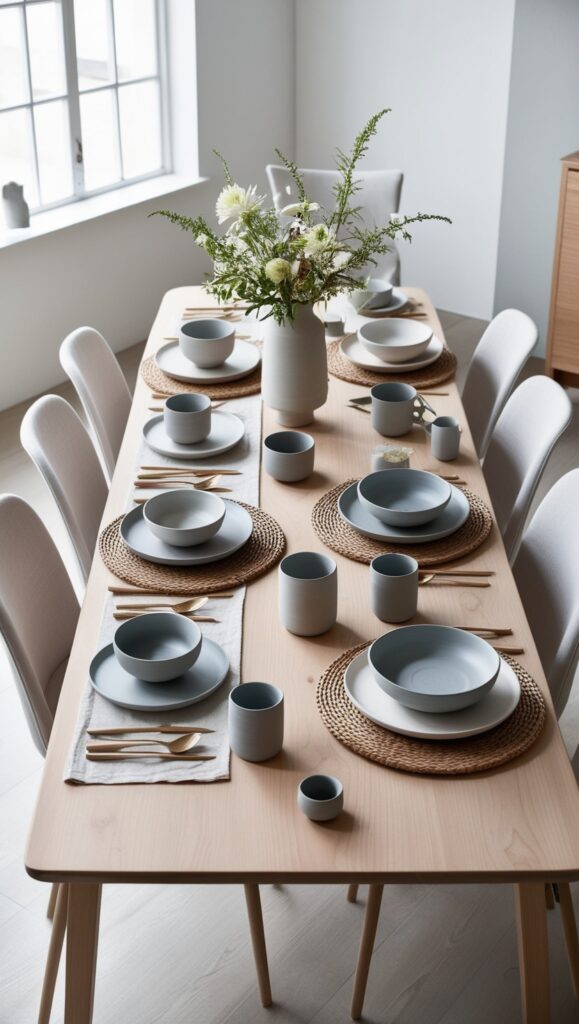
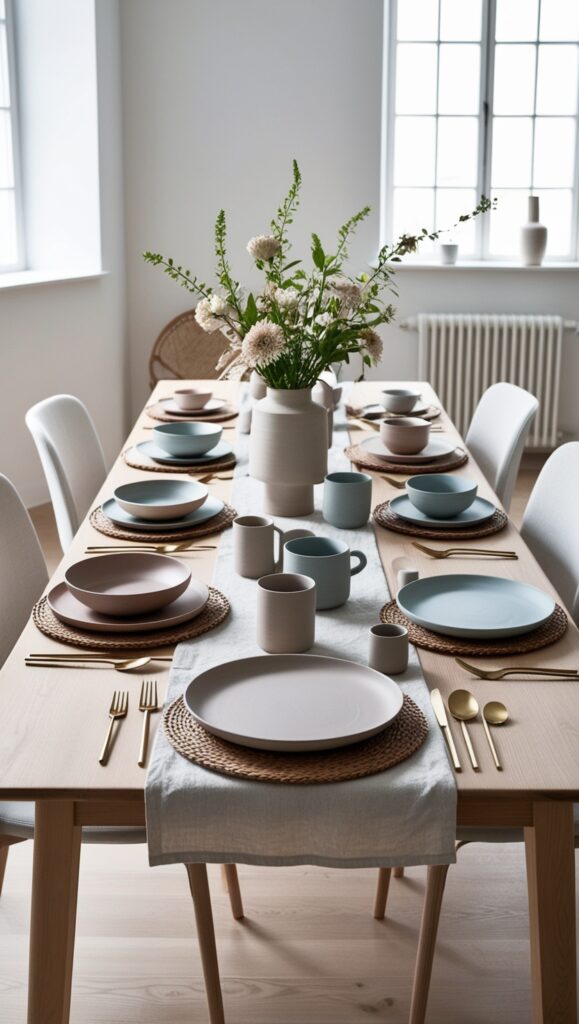
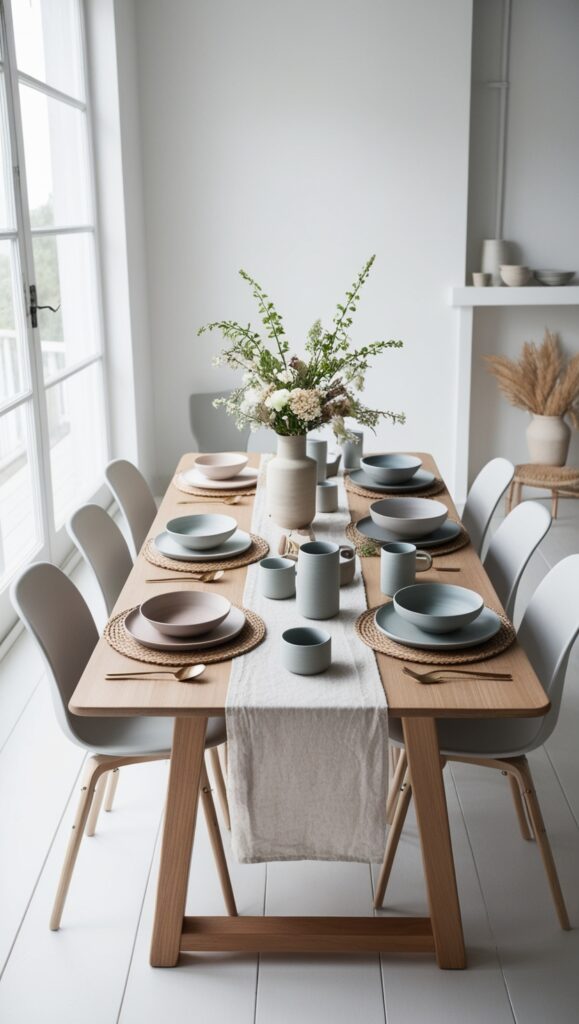
- Simplicity and Functionality:
- Design Philosophy: Scandinavian design prioritizes clean lines and uncomplicated forms, and ceramic tableware perfectly aligns with this philosophy. The focus is on practical, functional pieces that serve their intended purpose without unnecessary embellishments.
- Everyday Use: Ceramic tableware is not just for special occasions; it is designed for everyday use. The durability and practicality of ceramics make them suitable for both casual meals and more formal dining settings, reflecting a lifestyle that values both aesthetics and functionality.
- Muted Color Palettes:
- Natural Tones: One of the hallmarks of Scandinavian design is the use of muted, earthy colors. Ceramic tableware often features soft whites, grays, blues, and subtle pastels that harmonize beautifully with the overall decor. These colors contribute to a calming and cohesive atmosphere in the kitchen or dining area.
- Timeless Appeal: The understated color palette of ceramic tableware allows it to remain timeless and versatile, easily fitting into various decor styles and seasonal changes without feeling dated.
- Natural Textures:
- Tactile Quality: Many ceramic pieces feature natural textures that enhance their visual appeal. Glazes may have a matte finish, or the surfaces may be left unglazed, providing a tactile experience that draws the eye and invites touch. This emphasis on texture adds depth and warmth to minimalist settings.
- Handcrafted Aesthetic: The organic feel of ceramic tableware often evokes a handcrafted quality, which is highly valued in Scandinavian design. Handcrafted pieces may feature subtle imperfections that add character and uniqueness, making each item special.
- Versatile Styling:
- Layering and Mixing: Ceramic tableware can be easily mixed and matched, allowing homeowners to create personalized table settings. By combining different shapes, sizes, and colors, one can achieve a visually interesting and cohesive dining experience.
- Decorative Accents: Beyond functionality, ceramic pieces can also serve as decorative accents. Bowls and platters can be displayed on open shelves or dining tables, enhancing the aesthetic of the space even when not in use.
- Cultural Significance:
- Nordic Heritage: The use of ceramic tableware reflects the rich cultural heritage of the Nordic countries, where craftsmanship and quality materials are highly regarded. Many Scandinavian designers and brands focus on creating beautiful, functional ceramics that celebrate this heritage.
- Traditional Techniques: Some ceramic pieces are made using traditional techniques that have been passed down through generations. This connection to history adds depth to the design and enhances the story behind each piece.
- Sustainability:
- Eco-Friendly Materials: Many ceramic tableware pieces are made from natural materials and can be produced sustainably. Choosing ceramics over disposable or plastic options aligns with a commitment to eco-friendly living, which is an integral aspect of Scandinavian culture.
- Durability and Longevity: High-quality ceramic tableware is built to last, reducing the need for frequent replacements. This durability contributes to a sustainable lifestyle, as investing in quality pieces minimizes waste.
- Creating Inviting Spaces:
- Warm and Inviting Atmosphere: Ceramic tableware helps create an inviting dining environment. When paired with natural wood or textiles, it enhances the warmth of the space, encouraging gatherings and shared meals.
- Fostering Connection: The simplicity and beauty of ceramic tableware encourage mindfulness during mealtimes, allowing individuals to appreciate the experience of sharing food and connecting with others.

- Large Mirrors
Large mirrors not only reflect light but also make spaces feel bigger and airier, a key feature of Scandinavian homes. A well-placed mirror can brighten even the smallest rooms.
Large mirrors are a fundamental design element in Scandinavian interiors, playing a crucial role in enhancing the aesthetics and functionality of a space. Here’s a more in-depth exploration of their significance and features:

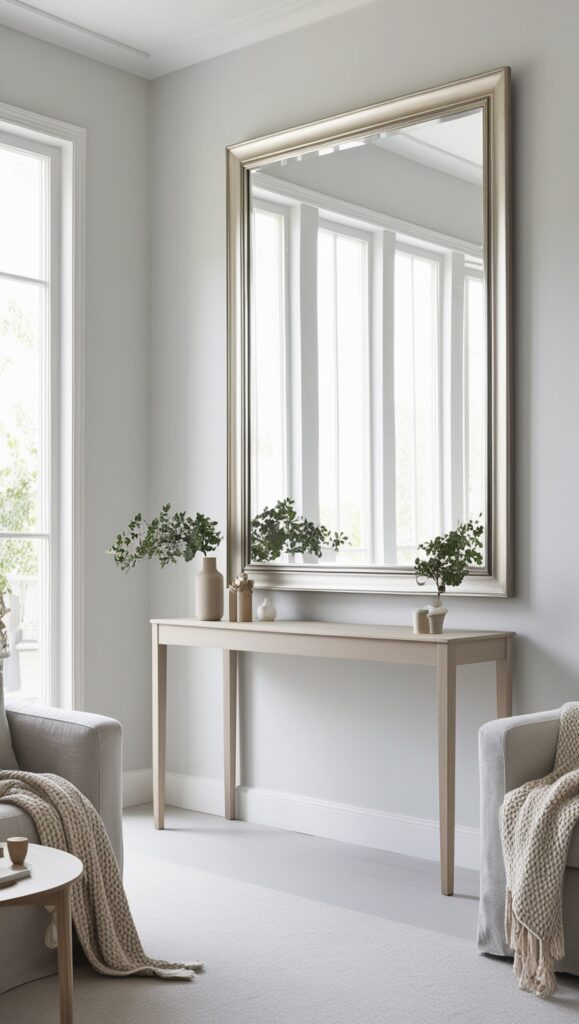
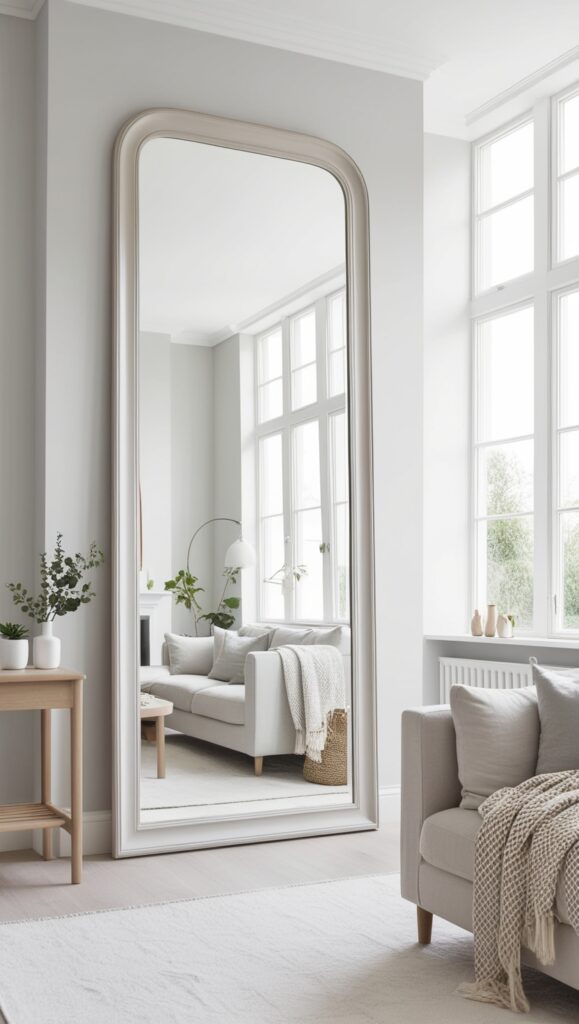
- Creating Illusions of Space:
- Visual Expansion: One of the primary benefits of large mirrors is their ability to create the illusion of space. In often compact Scandinavian homes, mirrors can make small rooms appear larger and more open. By reflecting walls and light, they visually expand the area, contributing to a feeling of airiness.
- Light Reflection: Mirrors effectively bounce light around a room, maximizing natural and artificial light sources. This not only brightens spaces but also enhances the overall ambiance, making interiors feel more inviting.
- Enhancing Natural Light:
- Brightening Dark Areas: Large mirrors are particularly useful in darker corners or smaller rooms that lack sufficient natural light. Strategically placing a mirror opposite a window or light source can amplify the brightness and warmth of the space, reducing the need for artificial lighting during the day.
- Mood Enhancement: Increased natural light from mirrors can improve the overall mood of a space. Bright, well-lit environments are often associated with positivity and energy, aligning with the Scandinavian ethos of creating comfortable and uplifting living spaces.
- Stylish Decor Elements:
- Minimalist Design: In Scandinavian design, large mirrors are often characterized by clean lines and simple frames, aligning with the minimalist aesthetic. The focus is on functionality, allowing the mirror itself to be a statement piece without overpowering other decor elements.
- Variety of Styles: While maintaining simplicity, large mirrors can come in various styles, including round, rectangular, or even abstract shapes. This versatility allows homeowners to select mirrors that complement their existing decor, whether modern or traditional.
- Functional Uses:
- Practical Applications: Beyond their decorative and aesthetic value, large mirrors serve practical purposes, such as providing a full-length view for getting dressed or checking one’s appearance. They are functional pieces that enhance daily routines while contributing to the overall design.
- Room Dividers: In open-plan spaces, large mirrors can also act as subtle dividers, helping to delineate areas without blocking light or sightlines. This can be particularly beneficial in multifunctional spaces that serve various purposes.
- Focal Points and Art:
- Creating Focal Points: A well-placed large mirror can serve as a focal point in a room. By drawing the eye, it can guide the overall flow of the space and highlight other design elements, such as furniture or artwork.
- Decorative Framing: Many large mirrors feature decorative frames that can add a touch of personality to the decor. Whether opting for a rustic wood finish or a sleek metallic look, the frame can enhance the mirror’s impact while blending with the overall aesthetic.
- Sustainability:
- Quality Materials: Many Scandinavian designers prioritize sustainability, often using high-quality, durable materials for large mirrors. Investing in well-made mirrors not only ensures longevity but also aligns with eco-friendly practices that value craftsmanship and sustainability.
- Timeless Investment: Large mirrors can be timeless additions to a home, transcending trends. Their enduring design makes them a worthwhile investment that can adapt to changing decor styles over time.
- Personal Expression:
- Reflecting Style: Large mirrors can reflect the homeowner’s personal style and taste. Choosing mirrors with unique designs or frames can add character to a space, allowing individuals to express themselves through their decor choices.
- Incorporating Art: Some homeowners may choose to incorporate mirrors that double as art pieces, adding a creative twist to their decor. This blend of functionality and artistic expression aligns well with the Scandinavian approach to design.

- Functional Storage
Scandinavian homes prioritize function without sacrificing style. Simple storage solutions, like woven baskets, help keep the space organized and free of clutter.
Functional storage is a key principle in Scandinavian design, embodying the philosophy of combining practicality with aesthetic appeal. Here’s a more detailed exploration of its significance and features in Scandi interiors:


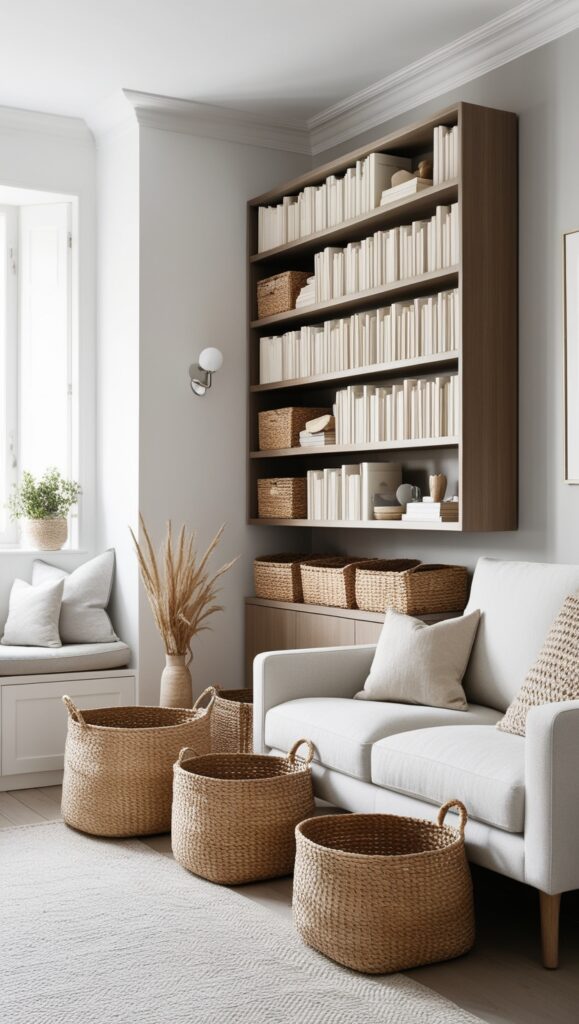
- Emphasis on Practicality:
- Purpose-Driven Design: Scandinavian homes are designed with functionality at their core. Storage solutions are not just about hiding away clutter but are thoughtfully integrated into the overall design of the space. Every item serves a purpose, ensuring that the home remains organized and efficient.
- Smart Use of Space: In often compact Scandinavian homes, maximizing space is essential. Functional storage solutions, such as built-in cabinets, shelving, and multifunctional furniture, are used to create storage without sacrificing valuable floor space. This approach helps maintain an uncluttered environment, essential for the minimalist aesthetic.
- Stylish Organization:
- Aesthetic Appeal: Functional storage in Scandinavian design is not merely utilitarian; it’s also visually appealing. Items like woven baskets, stylish boxes, and sleek shelving units are chosen for their design, contributing to the overall decor. This blend of function and style helps create a cohesive and inviting atmosphere.
- Natural Materials: Many storage solutions feature natural materials like wood, rattan, or wicker, which align with the Scandi ethos of using organic and sustainable resources. These materials add warmth and texture to the space, enhancing the overall aesthetic while serving a practical purpose.
- Variety of Solutions:
- Woven Baskets: Woven baskets are a popular choice for functional storage in Scandinavian homes. They are versatile, lightweight, and come in various sizes and styles, making them perfect for organizing items in living rooms, bathrooms, and bedrooms. Baskets can hold everything from toys to blankets while adding a decorative touch.
- Multi-Functional Furniture: Scandinavian design often incorporates furniture that serves dual purposes, such as ottomans with storage space inside or coffee tables that double as storage units. This approach maximizes utility while minimizing clutter, making it ideal for small spaces.
- Decluttering and Minimalism:
- Clutter-Free Living: A key aspect of Scandinavian interiors is the commitment to decluttering. Functional storage solutions make it easier to keep spaces tidy and organized, promoting a calm and peaceful environment. The focus is on quality over quantity, encouraging homeowners to curate their belongings mindfully.
- Visible vs. Hidden Storage: Scandinavian design often balances visible and hidden storage. Open shelving can display beautiful items or books, while closed cabinets or baskets can hide less attractive items, allowing for both organization and aesthetic appeal.
- Incorporating Nature:
- Connection to Nature: Many functional storage pieces in Scandinavian homes emphasize a connection to nature. Natural wood finishes and earthy tones create a harmonious blend with other decor elements, contributing to a serene environment that reflects the beauty of the outdoors.
- Eco-Friendly Practices: Scandinavian design champions sustainability, and many storage solutions are made from environmentally friendly materials. This commitment to eco-conscious living aligns with the broader Scandinavian values of preserving nature and creating a healthier home environment.
- Flexibility and Adaptability:
- Dynamic Spaces: Scandinavian homes often prioritize flexibility, allowing for easy reconfiguration of spaces. Functional storage solutions can adapt to changing needs, making it easy to modify layouts and functions as lifestyles evolve.
- Customizable Options: Many storage solutions are customizable, enabling homeowners to create systems that work best for their specific needs. This adaptability is particularly valuable in multifunctional spaces where versatility is essential.
- Personal Touch:
- Reflecting Personal Style: Functional storage can also reflect the homeowner’s personal style. By choosing storage solutions that align with their taste, individuals can create a space that is both organized and uniquely theirs. This approach allows for creative expression while maintaining the principles of functionality and minimalism.

Also Read: 5 Unique and Creative Pumpkin Painting Ideas for Stunning Fall and Halloween Decor

